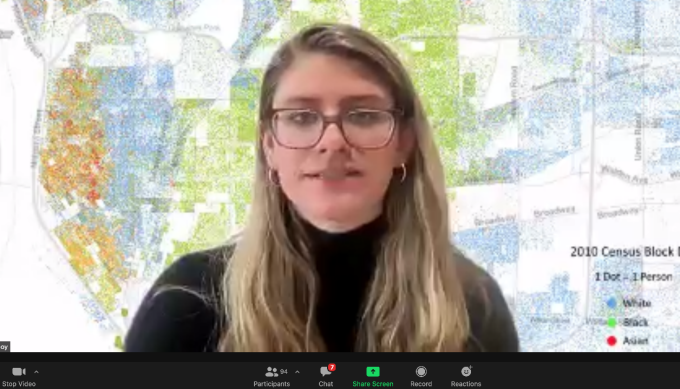
Laura Conboy '22 presents a persuasive case at a public meeting of the Partnership for the Public Good.
Dismantling persistent housing segregation in Erie County
Backed by a groundswell of community support, a proposal by two law students has been voted onto the competitive Community Agenda for 2022 organized by the Partnership for the Public Good.
Laura Conboy ’22 and Tracey Malcolm ’22, are student attorneys in UB School of Law’s Civil Rights and Transparency Clinic. They propose that Erie County leverage new fair housing laws and create incentives among local cities and towns to reduce segregation.
Housing segregation by race is one of the region’s most persistent problems. The Buffalo metropolitan region consistently ranks among the most segregated places in the country. The numbers are startling: 75 percent of the county’s Black residents live in the City of Buffalo, but only 19 percent of white county residents do. Segregation is a significant factor driving the region’s racial wealth gap. Clinic students explain that this segregation disproportionately harms quality of life for Black residents, including lack of access to health care, education, and other opportunities.
They say one solution is to dismantle exclusionary zoning laws in Erie County’s 28 municipalities. The most exclusionary laws—which are relics of a long history of racism that led to segregation—are barriers to housing choice for people of all races because they make it difficult to build affordable multiple family housing. According to a White House report on exclusionary zoning, “common examples include minimum lot size requirements, minimum square footage requirements, prohibitions on multi-family housing, and limits on the height of buildings.” While the origins of zoning laws date back to the nineteenth century to mitigate fire and environmental hazards, “in the subsequent decades, some zoning laws have been used to discriminate against people of color and to maintain property prices in suburban, and more recently, urban neighborhoods.”
The students presented a persuasive case at a public meeting of the Partnership for the Public Good, where they gave a rapid-fire “pitch” on the importance of their proposal, earning a spot on the agenda. With this designation, PPG will support the Clinic and its partner, fair housing nonprofit Housing Opportunities Made Equal, with advocacy training to convince lawmakers to reform existing zoning laws.
Conboy, a third-year student, was allotted two minutes to present the proposal. “It was certainly a challenge to do it in that time,” she says. “We wanted to make sure we fully addressed the scope of the problem and offered feasible solutions.” She noted that the federal Department of Housing and Urban Development is poised to issue new fair-housing regulations by March. As a recipient of federal aid, Erie County must comply, which opens the door to new conversations about segregation.
See Also
- Partnership for the Public Good’s media release
- Partnership for the Public Good’s 2022 Community Agenda
- Learn more about the Civil Rights and Transparency Clinic
- Support the Clinic’s work
More clinic success

Erie County taxpayers—who may be asked to pay as much as $1 billion to build a new football stadium for the Buffalo Bills—now have access to critical information around the proposals, thanks to a successful lawsuit brought by UB School of Law’s Civil Rights and Transparency Clinic.
“Segregation is not a problem we have tried and failed to solve here. We’ve never really tried. Behind the problems is a root cause— segregation—we need to treat the disease and not just the symptoms,” Conboy said in her pitch.
The student team is advised by the Clinic’s director, Professor Heather Abraham, whose fair housing expertise includes legal mechanisms and strategies to reduce segregation. “In developing this proposal,” she explained, “the student attorneys reached out to stakeholders, which helped them develop their message: racial segregation is a problem that underlies and reinforces many of the other inequities featured on the Community Agenda. Given that relationship, it’s critical that we take on this problem directly.”
“Housing segregation affects all aspects of human lives,” says Malcolm, who’s in the final semester of the law school’s two-year J.D. program for internationally trained lawyers. (A native of Jamaica, she attended law school in London.) “It affects education, it affects health, it affects the type of jobs and opportunities that are open to you. Discriminatory zoning polices are basically the guard at the front door that tells a person of color or an ethnic minority that you’re not welcome.”
“Where you live matters,” says Daniel Corbitt, associate director of Housing Opportunities Made Equal, or HOME. “For nearly 60 years, HOME has fought to promote the value of diversity and ensure all people an equal opportunity to live in the housing and communities of their choice. Despite progress over that period, significant obstacles to true housing choice remain. Exclusionary zoning exacerbates segregation and inequality, and must be dismantled through a multi-pronged effort to ensure everyone has access to the resources and opportunities necessary to succeed and thrive. HOME is proud to be part of this innovative and comprehensive strategy to remove barriers to opportunity and make our community a more just and equitable place for all.”
Clinic students will continue working on the issue through the spring semester and likely into the future. That work entails making connections with lawmakers and other advocates, as well as building community support for the project. The plan is to build a coalition of community stakeholders, press Erie County to incentivize zoning reform as one of the ways it satisfies its federal and state fair housing obligations, and find ways to hold municipalities accountable for progress.
“Through this Clinic and our matter, we were able to research and learn so much about how segregation is embedded throughout the country and especially in Erie County,” Conboy says. “It’s meaningful to me to be an active participant in addressing segregation in our community.”